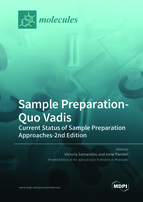Sample Preparation-Quo Vadis: Current Status of Sample Preparation Approaches-2nd Edition
A special issue of Molecules (ISSN 1420-3049). This special issue belongs to the section "Analytical Chemistry".
Deadline for manuscript submissions: closed (10 March 2022) | Viewed by 32384
Special Issue Editors
Interests: analytical chemistry; sample preparation; chromatography; HPLC; method validation; method development; separation science; food analysis; bioanalysis; environmental analysis; green analytical chemistry; sorptive extraction; microextraction techniques
Special Issues, Collections and Topics in MDPI journals
Interests: pharmaceutical analysis; analytical chemistry; analytical methods; drug analysis, metabolites; bioactive compounds; pharmaceuticals; cosmeceuticals
Special Issues, Collections and Topics in MDPI journals
Special Issue Information
Dear Colleagues,
Sample preparation is, and will always be, the most important step in chemical analysis. Numerous techniques, methods, methodologies, and approaches are published in the literature, offering a wide range of analytical tools to the lab practitioner. Analytical scientists all over the world are committed to developing protocols for a plethora of analytes in various sample matrices. In the past decade, advances in sample pretreatment has followed the demand for green chemistry and green analytical chemistry, focusing on miniaturization and automation, using the least possible amount of organic solvents. The question is, how far have we come, and what are the future perspectives? Analytical chemists are invited to share their experience in the field and report on the recent advances in sample preparation approaches.
This Special Issue is supported by the Sample Preparation Study Group and Network, supported by the Division of Analytical Chemistry of the European Chemical Society.
Prof. Dr. Victoria Samanidou
Prof. Dr. Irene Panderi
Guest Editors
Manuscript Submission Information
Manuscripts should be submitted online at www.mdpi.com by registering and logging in to this website. Once you are registered, click here to go to the submission form. Manuscripts can be submitted until the deadline. All submissions that pass pre-check are peer-reviewed. Accepted papers will be published continuously in the journal (as soon as accepted) and will be listed together on the special issue website. Research articles, review articles as well as short communications are invited. For planned papers, a title and short abstract (about 100 words) can be sent to the Editorial Office for announcement on this website.
Submitted manuscripts should not have been published previously, nor be under consideration for publication elsewhere (except conference proceedings papers). All manuscripts are thoroughly refereed through a single-blind peer-review process. A guide for authors and other relevant information for submission of manuscripts is available on the Instructions for Authors page. Molecules is an international peer-reviewed open access semimonthly journal published by MDPI.
Please visit the Instructions for Authors page before submitting a manuscript. The Article Processing Charge (APC) for publication in this open access journal is 2700 CHF (Swiss Francs). Submitted papers should be well formatted and use good English. Authors may use MDPI's English editing service prior to publication or during author revisions.
Keywords
- sample preparation
- sample pretreatment
- extraction techniques
- microextraction techniques
- green analytical chemistry
- miniaturization
- automated techniques








